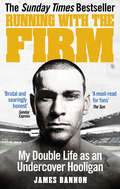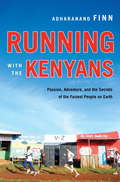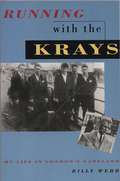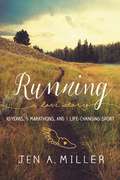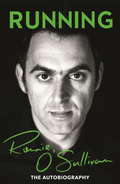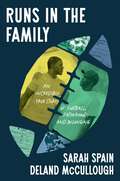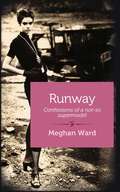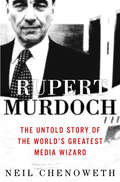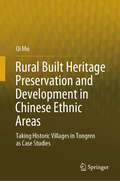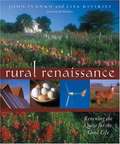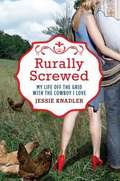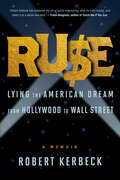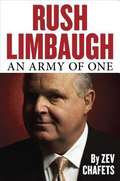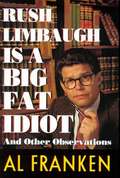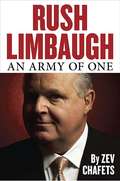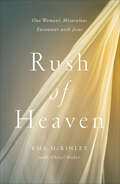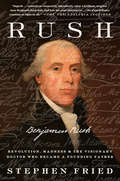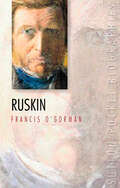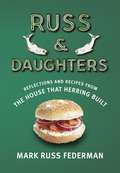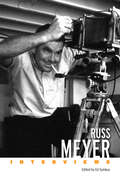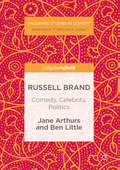- Table View
- List View
Running with the Firm
by James Bannon'Of course I'm a f**king hooligan, you pr**k. I am a hooligan...there I've said it...I'm a hooligan. And, do you know why? Because that's my f**king job.'In 1995, a film called I.D., about an ambitious young copper who was sent undercover to track down the ‘generals’ of a football hooligan gang, achieved cult status for its sheer brutality and unsettling insight into the dark and often bloody side of the so-called beautiful game.The film was so shocking it was hard to believe the mindless events that took place could ever happen in the real world. Well, believe it now...Almost twenty years on, the man behind the film has explosively revealed that the script was largely a true story. That man, James Bannon, was the ambitious undercover cop. The football club was Millwall F.C. and the gang that he infiltrated was The Bushwackers, among the most brutal and fearless in English football. In Running with the Firm, Bannon shares his intense and dangerous journey into the underworld of football hooliganism where sickening levels of violence prevail over anything else. He introduces you to the hardest thugs from football’s most notorious gangs, tells all about the secret and almost comical police operations that were meant to bring them down, and, how once you’re on the inside, getting out from the mob proves to be the biggest mission of all.A disturbing but compelling read, this is the book that proves fact really is stranger than fiction.
Running with the Kenyans: Discovering the Secrets of the Fastest People on Earth
by Adharanand Finn"A dusty road stretches into the distance like a pencil line across the arid landscape. Lions, rhino, and buffalo roam the plains on either side. But I haven't come to Kenya to spot wildlife. I've come to run." Whether running is your recreation, your religion, or just a spectator sport, Adharanand Finn's incredible journey to the elite training camps of Kenya will captivate and inspire you. Part travelogue, part memoir, this mesmerizing quest to uncover the secrets of the world's greatest runners--and put them to the test--combines practical advice, a fresh look at barefoot running, and hard-won spiritual insights. As a boy growing up in the English countryside, Adharanand Finn was a natural runner. While other kids struggled, he breezed through schoolyard races, imagining he was one of his heroes: the Kenyan long-distance runners exploding into prominence as Olympic and world champions. But as he grew up, pursued a career in journalism, married and had children, those childhood dreams slipped away--until suddenly, in his mid-thirties, Finn realized he might have only one chance left to see how far his talents could take him. Uprooting his family of five, including three small children, Finn traveled to Iten, a small, chaotic town in the Rift Valley province of Kenya--a mecca for long-distance runners thanks to its high altitude, endless running paths, and some of the top training schools in the world. Finn would run side by side with Olympic champions, young hopefuls, and barefoot schoolchildren . . . not to mention the exotic--and sometimes dangerous--wildlife for which Kenya is famous. Here, too, he would meet a cast of colorful characters, including his unflappable guide, Godfrey Kiprotich, a former half marathon champion; Christopher Cheboiboch, one of the fastest men ever to run the New York City Marathon; and Japhet, a poor, bucktoothed boy with unsuspected reservoirs of courage and raw speed. Amid the daily challenges of training and of raising a family abroad, Finn would learn invaluable lessons about running--and about life. Running with the Kenyans is more than one man's pursuit of a lifelong dream. It's a fascinating portrait of a magical country--and an extraordinary people seemingly born to run.
Running with the Krays: My Life in London's Gangland
by Billy WebbRunning with the Krays lifts the liid off London's underworld, from street gangs and race-course con games to protection rackets, beatings, maimings, intimidation and even murders. It reveals elements of police corruption and provides insights into the interdependence of both sides of the underworld scene - a compelling and gruesome account of how the other half of London lives.Born in wartime London's east end, Billy Webb grew up in the violence of air-raids and street warfare. His first weapon was a knuckleduster which he had made to measure for the price of five cigarettes when he was 11. When he first met the Krays they were scraping a living by doorknocking for old clothes to be sold in street markets. For three years he and the twins were on the run together as army deserters, and over the course of time, he was a friend, ally and foe of the Krays in their violent rise to fame.
Running: 10 Years, 5 Marathons, and 1 Life-Changing Sport
by Jen A. MillerJen Miller has fallen in and out of love, but no man has been there for her the way running has.In Running: A Love Story, Jen tells the story of her lifelong relationship with running with wit, thoughtfulness, and brutal honesty. Jen first laces up her sneakers in high school, when, like many people, she sees running as a painful part of conditioning for other sports. But when she discovers early in her career as a journalist that it helps her clear her mind, focus her efforts, and achieve new goals, she becomes hooked for good.Jen, a middle-of-the-pack but tenacious runner, hones her skill while navigating relationships with men that, like a tricky marathon route, have their ups and downs, relying on running to keep her steady in the hard times. As Jen pushes herself toward ever-greater challenges, she finds that running helps her walk away from the wrong men and learn to love herself while revealing focus, discipline, and confidence she didn't realize she had.Relatable, inspiring, and brutally honest, Running: A Love Story, explores the many ways that distance running carves a path to inner peace and empowerment by charting one woman's evolution in the sport.
Running: The Autobiography
by Ronnie O'SullivanI used to rely on drugs and alcohol to keep me going, but now I've got the healthiest addiction going - running. This book explains how running has helped me to fight my demons - my addictive personality, depression, my dad's murder conviction, the painful break-up with the mother of my children - and allowed me to win five World Snooker Championships. It is also about all of the great things in my life - my kids, snooker, my dad's release from prison, great mates who have helped me, and the psychiatrist Dr Steve Peters, who has taught me how not to run away when things get tough. Finally, it's about what it's like to get the buzz - from running, from snooker, from life. Because when it comes down to it, everyone needs something to drive them on.g.This is a book about what it takes to be a champion - the sacrifices you have to make, the obsessive practice, the selfishness. Finally, it's a book about what it's like to get the buzz. and I hope anybody who's ever got the running buzz will relate to this.
Running: The Autobiography
by Ronnie O'SullivanWorld Snooker Champion Ronnie O'Sullivan's frank and honest account of his astonishingly dramatic life.I used to rely on drugs and alcohol to keep me going, but now I've got the healthiest addiction going - running.This book explains how running has helped me to fight my demons - my addictive personality, depression, my dad's murder conviction, the painful break-up with the mother of my children - and allowed me to win five World Snooker Championships.It is also about all of the great things in my life - my kids, snooker, my dad's release from prison, great mates who have helped me, and the psychiatrist Dr Steve Peters, who has taught me how not to run away when things get tough.Finally, it's about what it's like to get the buzz - from running, from snooker, from life. Because when it comes down to it, everyone needs something to drive them on.
Runs in the Family: An Incredible True Story of Football, Fatherhood, and Belonging
by Sarah Spain Deland McCulloughDiscover a powerful exploration of identity, family, and fatherhood through the true story of an adopted Black man searching for his biological family. Uncover the profound impact of the choices we make as fathers, sons, and individuals finding where we belong. A heartfelt read for anyone reflecting on the meaning of fatherhood and connection this Father&’s Day.Runs in the Family follows the remarkable true story of Deland McCullough, a football coach and father of four whose life was forever changed by the unsealing of his adoption records. His hidden past harbored an astonishing secret. In 1972, sixteen-year-old Carol Briggs gave birth to Jon Kenneth Briggs during a snowstorm in Pittsburgh and made the difficult decision to put him up for adoption, hoping he would land in a stable, two-parent household. Adopted by a well-known Youngstown, Ohio, radio DJ and his wife, Jon was renamed Deland McCullough. Deland&’s childhood was far from idyllic, disrupted by his adoptive parents&’ turbulent divorce and his mother&’s subsequent abusive relationships. Amid this uncertainty and instability at home, football became a sanctuary, providing Deland with mentorship and a sense of belonging. He learned to channel his insecurities and feelings of disconnection into an unrelenting drive to prove his doubters wrong and surpass the expectations others had for him. After making the transition from professional player to respected coach, Deland&’s longing to understand his origins intensified, driven by a desire to fill out his family medical history and piece together the fragmented parts of his identity. The search that ensued led to a life-altering discovery, an examination of family in all its forms, and an exploration of all the ways we inherit, learn, and disrupt generational trauma. Based on Emmy and Peabody Award–winning sports journalist Sarah Spain&’s viral ESPN article, Runs in the Family is an emotional examination of the sacrifices, choices, and nurturing that shape us and our loved ones. It offers a heartfelt testament to the profound impact of family and the kind of love and mentorship that can forge enduring bonds that transcend biology.
Runway: Confessions of a Not-So-Supermodel
by Meghan WardFresh out of Catholic high school, Michigan girl Meghan Ward heads for the Paris runways at the tender age of 18. She had never intended to be a model. In fact, she had the typical thinking-person&’s qualms about the industry, particularly the unhealthy images of women it promotes. But she had the looks, and when a scout approached her, she couldn&’t resist the chance to sample the glamour of the modeling scene—and rack up some money for college. Runway, her thoughtful yet dishy memoir, tells the story of what she learned about the world of high-fashion modeling—and herself.
Rupert Murdoch: The Untold Story of the World's Greatest Media Wizard
by Neil ChenowethIf you want to understand how modern media has changed the world, this is the one book you must read. Rupert Murdoch is the man everyone talks about but no one knows. He's everywhere, a larger-than-life media titan who has spent a lifetime building his company, News Corporation, from a small, struggling newspaper business in Australia into an international media powerhouse. Rupert Murdoch charts the real story behind the rise of News Corp and the Fox network: the secret debt crises and family deals, the huge cash flows through the offshore archipelagos, the New York party that saved his empire, the covert government inquiries, the tax investigations, and the bewildering duels with Bill Gates, Ted Turner, Gerry Levin, Ron Perelman, Newt Gingrich, cable king John Malone, Michael Eisner, Tony Blair, and televangelist-turned-diamond-miner Pat Robertson. Murdoch's story, however, is more than just how one man built a global business. Rupert Murdoch is both a biography of Murdoch the man (including the divorce from his wife, Anna; his remarriage to a woman young enough to be his granddaughter; and the struggle between his two sons for eventual control of the family holdings) and a "follow the money" investigation that reveals how he has managed to have such a huge impact on the communications revolution that promises to utterly transform life in the twenty-first century. The investigation concentrates on Murdoch's three great campaigns: in the 1980s, when his determination to launch an American television network overturned the media industries of three countries; in 1997, when Murdoch took on every broadcasting group in America; and the process of reinventing himself since then, culminating in his bid to win DirecTV from General Motors. This is the saga of the man who has stalked, infuriated, cajoled, threatened, and spooked the media industry for three decades, whose titanic gambles have shaped and reshaped the media landscape. Win or lose, Murdoch is the man who has changed everything. And Neil Chenoweth is the right person to tell the story: In 1990 he wrote a magazine article that prompted a secret Australian government inquiry into Rupert Murdoch's family companies, and he's been on the Murdoch case since then. Chenoweth reveals what no person ever has about the man (and the company) who is probably the most significant media player of them all.
Rural Built Heritage Preservation and Development in Chinese Ethnic Areas: Taking Historic Villages in Tongren as Case Studies
by Qi MuThis book discusses how rural built heritage preservation and development in the Chinese ethnic area in Tongren, China has been strongly addressed by the labeling, planning, project-making, follow-up management characterized by different patterns of stakeholders. Moreover, the rural built heritage preservation and development is an instrument of power that has been incorporated into the municipal, county and lower-level planning settings, portraying an overall top-down government-led feature. An intentional laddered development for the government’s overall strategy of resource allocation and spatial reorganization has been identified. Different patterns of stakeholders are identified. This book discusses how different roles played by stakeholders tend to be inseparable and often overlapped thus forming ambiguous and difficulty controllable dynamics in shaping the rural built environment. In conclusion, insights have been provided based on the debates of AHD and positioning rural built heritage preservation within the public governance.
Rural Renaissance: Renewing The Quest For The Good Life
by Bill Mckibben John D. Ivanko Lisa KiviristIn the '60s it was called the "back to the land" movement, and in Helen and Scott Nearings' day, it was "living the good life. " Whatever the term, North Americans have always yearned for a simpler way. But how do you accomplish that today? Blending inspiration with practical how-to's, Rural Renaissance captures the American dream of country living for contemporary times. Journey with the authors and experience their lessons, laughter and love for the land as they trade the urban concrete maze for a five-acre organic farm and bed and breakfast in southwestern Wisconsin. Rural living today is a lot more than farming. It's about a creative, nature-based and more self-sufficient lifestyle that combines a love of squash, solar energy, skinny-dipping and serendipity . . . The many topics explored in Rural Renaissance include: "right livelihood" and the good life organic gardening and permaculture renewable energy and energy conservation wholesome organic food, safe water and a natural home simplicity, frugality and freedom green design and recycled materials community, friends and raising a family independence and interdependence wildlife conservation and land stewardship. An authentic tale of a couple whose pioneering spirit and connection to the land reaches out to both the local and global community to make their dream come true, Rural Renaissance will appeal to a wide range of Cultural Creatives, free agents, conservation entrepreneurs and both arm-chair and real-life homesteaders regardless of where they live. Lisa Kivirist and John Ivanko are innkeepers, organic growers, copartners in a marketing consulting company, and have previously published books. John is also a photographer. Former advertising agency fast-trackers, they are nationally recognized for their contemporary approach to homesteading, conservation and more sustainable living. They share their farm with their son, two llamas, and a flock of free-range chickens. Rural Renaissance also offers a foreword by Bill McKibben.
Rurally Screwed
by Jessie KnadlerA magazine editor in New York, Jessie Knadler had a habit of always looking over her shoulder for better options. She wasn't quite sure moving to Montana and marrying a cowboy was a better option--but, head over heels in love, she did it anyway. At a loss in her new rural environment, she hoped that activities like chicken farming and fence building might provide her with a more profound, virtuous sense of self (and make her husband Jake love her even more). It all led her to some strange situations--and surprising realizations. Written with huge personality and searing wit, Rurally Screwed is an immensely entertaining and moving memoir about the things we do for love--and the lengths we'll go to find our true identity.
Ruse: Lying the American Dream from Hollywood to Wall Street
by Robert Kerbeck&“Kerbeck&’s juicy memoir tells riveting tales [with] the thrill of a spy novel. . . Kerbeck bares all of his wild business secrets within the world of corporate espionage&” --Foreword Reviews"Robert Kerbeck has mastered the art of social engineering, or what he calls 'rusing', and taken it to a whole new level." —Frank Abagnale, author of Catch Me If You Can B-list actor, A-list corporate spyIn the world of high finance, multibillion-dollar Wall Street banks greedily guard their secrets. Enter Robert Kerbeck, a working actor who made his real money lying on the phone, charming people into revealing their employers&’ most valuable information. In this exhilarating memoir that will appeal to fans of The Wolf of Wall Street and Catch Me If You Can, unsuspecting receptionists, assistants, and bigshot executives all fall victim to &“the Ruse.&” After college, Kerbeck rushed to New York to try to make it as an actor. But to support himself, he&’d need a survival job, and before he knew it, while his pals were waiting tables, he began his apprenticeship as a corporate spy. As his acting career started to take off, he found himself hobnobbing with Hollywood luminaries: drinking with Paul Newman, taking J.Lo to a Dodgers game, touring E.R. sets with George Clooney. He even worked with O.J. Simpson the week before he became America&’s most notorious double murderer. Before long, however, his once promising acting career slowed while the corporate espionage business took off. The ruse job was supposed to have been temporary, but Kerbeck became one of the world&’s best practitioners of this deceptive—and illegal—trade. His income jumped from tens of thousands to hundreds of thousands to millions of dollars a year. Until the inevitable crash… Kerbeck shares the lies he told, the celebrities he screwed (and those who screwed him), the cons he ran, and the money he made—and lost—along the way.
Rush Limbaugh
by Zev ChafetsDo you remember your first time? People tend to remember the moment they first heard The Rush Limbaugh Show on the radio. For Zev Chafets, it was in a car in Detroit, driving down Woodward Avenue. Limbaugh's braggadocio, the outrageous satire, the slaughtering of liberal sacred cows performed with the verve of a rock-n-roll DJ-it seemed fresh, funny and completely subversive. "They're never going to let this guy stay on the air," he thought. Almost two decades later Chafets met Rush for the first time, at Limbaugh's rarely visited "Southern Command. " They spent hours together talking on the record about politics, sports, music, show business, religion and modern American history. Rush opened his home and his world, introducing Chafets to his family, closest friends, even his psychologist. The result was an acclaimed cover-story profile of Limbaugh in The New York Times Magazine. But there was much more to say, especially after Limbaugh became Public Enemy Number One of the Obama Administration. At first Limbaugh resisted the idea of a full-length portrait, but he eventually invited Chafets back to Florida and exchanged more than a hundred emails full of his personal history, thoughts, fears and ambitions. What has emerged is an uniquely personal look at the man who is not only the most popular voice on the radio, but the leader of the conservative movement and one of the most influential figures in the Republican Party. While Limbaugh's public persona is instantly recognizable, his background and private life are often misunderstood. Even devoted Dittoheads will find there's a lot they don't know about the self-described "harmless little fuzzball" who has, over the years, taken on the giants of the mainstream media and the Democratic Party-from Bill and Hillary Clinton to Barack Obama-with "half his brain tied behind his back, just to make it fair. " Chafets paints a compelling portrait of Limbaugh as a master entertainer, a public intellectual, a political force, and a fascinating man. .
Rush Limbaugh is a Big Fat Idiot and Other Observations
by Al FrankenA snarky, sometimes vitriollic examination of the title proposition, as well as a number of other political scandals and issues of the past two decades.
Rush Limbaugh: An Army of One
by Zev Chafets"I know the liberals call you 'the most dangerous man in America,' but don't worry about it, they used to say the same thing about me. Keep up the good work. " -Ronald Reagan in a letter to Rush Limbaugh, December 11, 1992. Do you remember your first time? People tend to remember the moment they first heard The Rush Limbaugh Show on the radio. For Zev Chafets, it was in a car in Detroit, driving down Woodward Avenue. Limbaugh's braggadocio, the outrageous satire, the slaughtering of liberal sacred cows performed with the verve of a rock-n-roll DJ-it seemed fresh, funny and completely subversive. "They're never going to let this guy stay on the air," he thought. Almost two decades later Chafets met Rush for the first time, at Limbaugh's rarely visited "Southern Command. " They spent hours together talking on the record about politics, sports, music, show business, religion and modern American history. Rush opened his home and his world, introducing Chafets to his family, closest friends, even his psychologist. The result was an acclaimed cover-story profile of Limbaugh in The New York Times Magazine. But there was much more to say, especially after Limbaugh became Public Enemy Number One of the Obama Administration. At first Limbaugh resisted the idea of a full-length portrait, but he eventually invited Chafets back to Florida and exchanged more than a hundred emails full of his personal history, thoughts, fears and ambitions. What has emerged is an uniquely personal look at the man who is not only the most popular voice on the radio, but the leader of the conservative movement and one of the most influential figures in the Republican Party. While Limbaugh's public persona is instantly recognizable, his background and private life are often misunderstood. Even devoted Dittoheads will find there's a lot they don't know about the self-described "harmless little fuzzball" who has, over the years, taken on the giants of the mainstream media and the Democratic Party-from Bill and Hillary Clinton to Barack Obama-with "half his brain tied behind his back, just to make it fair. " Chafets paints a compelling portrait of Limbaugh as a master entertainer, a public intellectual, a political force, and a fascinating man.
Rush of Heaven: One Woman's Miraculous Encounter with Jesus
by Cheryl Ricker Ema McKinley"Ema, give me your hand." These were the words Jesus spoke to Ema on Christmas Eve--the night He straightened her crooked foot, hand, neck, and spine, and restored her mobility.Easter weekend, eighteen years earlier, an ordinary workday turned into a nightmare when Ema McKinley passed out and was left hanging upside down in the storage room.Rather than improving, Ema's body became progressively bent and disfigured. Doctors diagnosed Ema with reflex sympathetic dystrophy (RSD), an extremely painful trauma-induced disease which led to Ema's hand and foot deformities, painful sores, insomnia, gastrological distress, curvature of the neck and spine, heart and lung failure, and permanent confinement to a wheelchair.Once an athletic, powerhouse woman with multiple jobs and volunteer positions, Ema became a modern-day Job who lost everything except her faith and desire to trust God more fully. Ema wrestled with pain, anger, and unforgiveness, but now takes the reader on a healing miracle encounter of Biblical proportions.Rush of Heaven will ignite readers' passion for Jesus and help them walk hand-in-hand with Him through life's darkness. It will open hearts to embrace the impossible."Jesus gave me this miracle for you too!" -- Ema McKinley
Rush: Revolution, Madness, and Benjamin Rush, the Visionary Doctor Who Became a Founding Father
by Stephen FriedThe remarkable story of Benjamin Rush, medical pioneer and one of our nation’s most provocative and unsung Founding Fathers In the summer of 1776, fifty-six men put their quills to a dangerous document they called the Declaration of Independence. Among them was a thirty-year-old doctor named Benjamin Rush. One of the youngest signatories, he was also, among stiff competition, one of the most visionary. A brilliant physician and writer, Rush was known as the “American Hippocrates” for pioneering national healthcare and revolutionizing treatment of mental illness and addiction. Yet medicine is only part of his legacy. Dr. Rush was both a progressive thorn in the side of the American political establishment—a vocal opponent of slavery, capital punishment, and prejudice by race, religion or gender—and close friends with its most prominent leaders. He was the protégé of Franklin, the editor of Common Sense, Washington’s surgeon general, and the broker of peace between Adams and Jefferson, yet his stubborn convictions more than once threatened his career and his place in the narrative of America’s founding. Drawing on a trove of previously unpublished letters and images, the voluminous correspondence between Rush and his better-known counterparts, and his candid and incisive personal writings, New York Times bestselling author and award-winning journalist Stephen Fried resurrects the most significant Founding Father we’ve never heard of and finally installs Dr. Rush in the pantheon of great American leaders.
Ruskin
by Francis O'GormanJohn Ruskin was one of the greatest Victorian critics of art and society, but he was also preoccupied with politics, economics and education. This pocket-sized biography explores his influence on his own age and ours, examining his work, his relationships and his creative life.
Russ & Daughters: Reflections and Recipes from the House That Herring Built
by Calvin Trillin Mark Russ FedermanWITH 8 PAGES OF FULL-COLOR PHOTOGRAPHS AND BLACK-AND-WHITE IMAGES THROUGHOUTThe former owner/proprietor of the beloved appetizing store on Manhattan's Lower East Side tells the delightful, mouthwatering story of an immigrant family's journey from a pushcart in 1907 to "New York's most hallowed shrine to the miracle of caviar, smoked salmon, ethereal herring, and silken chopped liver" (The New York Times Magazine). When Joel Russ started peddling herring from a barrel shortly after his arrival in America from Poland, he could not have imagined that he was giving birth to a gastronomic legend. Here is the story of this "Louvre of lox" (The Sunday Times, London): its humble beginnings, the struggle to keep it going during the Great Depression, the food rationing of World War II, the passing of the torch to the next generation as the flight from the Lower East Side was beginning, the heartbreaking years of neighborhood blight, and the almost miraculous renaissance of an area from which hundreds of other family-owned stores had fled. Filled with delightful anecdotes about how a ferociously hardworking family turned a passion for selling perfectly smoked and pickled fish into an institution with a devoted national clientele, Mark Russ Federman's reminiscences combine a heartwarming and triumphant immigrant saga with a panoramic history of twentieth-century New York, a meditation on the creation and selling of gourmet food by a family that has mastered this art, and an enchanting behind-the-scenes look at four generations of people who are just a little bit crazy on the subject of fish.Color photographs © Matthew HranekFrom the Hardcover edition.
Russ Meyer: Interviews (Conversations with Filmmakers Series)
by Ed SymkusRuss Meyer: Interviews offers a detailed look into the mind, life, and successful career of the maverick filmmaker Russ Meyer. Known for his audacious visual style and boundary-pushing content, Meyer (1922–2004) carved out a unique niche in the film industry with his provocative and often controversial works, including Faster, Pussycat! Kill! Kill!; Beyond the Valley of the Dolls; and Vixen! In this volume, Meyer talks over the course of eighteen newspaper and magazine interviews—conducted between the late 1960s and early 1990s—about assignments in still- and motion-picture combat photography during World War II, learning all aspects of the filmmaking craft when he was shooting industrial films after the war, later stumbling into the business of photographing pin-up girls for magazines, and how that segued into his first forays in what would become the sexploitation movie market. Working with small budgets and small crews, Meyer became a skilled director and pitchman for his own work, hitting the road with reels of film in his car, going from town to town, getting them shown in small moviehouses, building an audience, making big profits, then using them to make his next film. The films were expertly photographed, inventively edited, and featured intriguing (and violent, carnal, and funny) storylines, and ticket sales numbers eventually caught the eyes of the Hollywood studio system, for which Meyer briefly worked, before once again striking out on his own with ever-more violent, sexual, and cartoonish features. Meyer made fortunes, he lost fortunes, then he made them again, and he was always game for getting involved in controversy, which was easy due to the content of his films. After his final theatrical feature—Beneath the Valley of the Ultra-Vixens—in 1979, Meyer reinvented himself as an entrepreneur by making his films available on the burgeoning home video market, leaving him a celebrated and very wealthy man.
Russell Brand: Comedy, Celebrity, Politics
by Jane Arthurs Ben LittleRussell Brand is one of the most high profile and controversial celebrities of our time. A divisive figure, his ability to bounce back from adversity is remarkable. This book traces his various career stages through which he has done this, moving from comedy, to TV presenting; from radio to Hollywood films. It identifies how this eclectic career in entertainment both helped and hindered his high-profile move into political activism. Underpinning the book are interviews with leading activists and politicians, and sophisticated readings of Brand's performances, writing and on-screen work. There are sections on the Sachsgate scandal, his Newsnight interview with Jeremy Paxman, and his 2015 election intervention for aspiring Prime Minister Ed Miliband. It builds on scholarly work in the area of celebrity politics to develop an original analytic approach that blends the field theory of Pierre Bourdieu with the assemblage theory of Gilles Deleuze and Felix Guattari.
